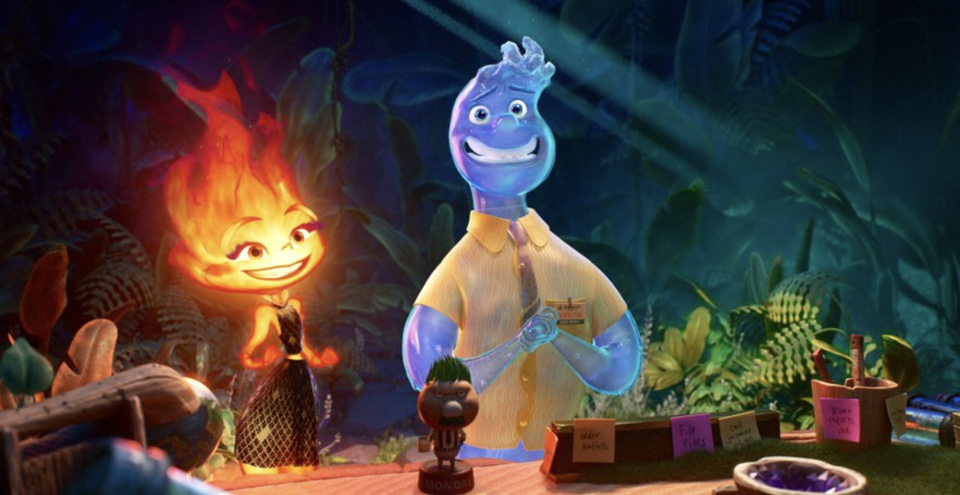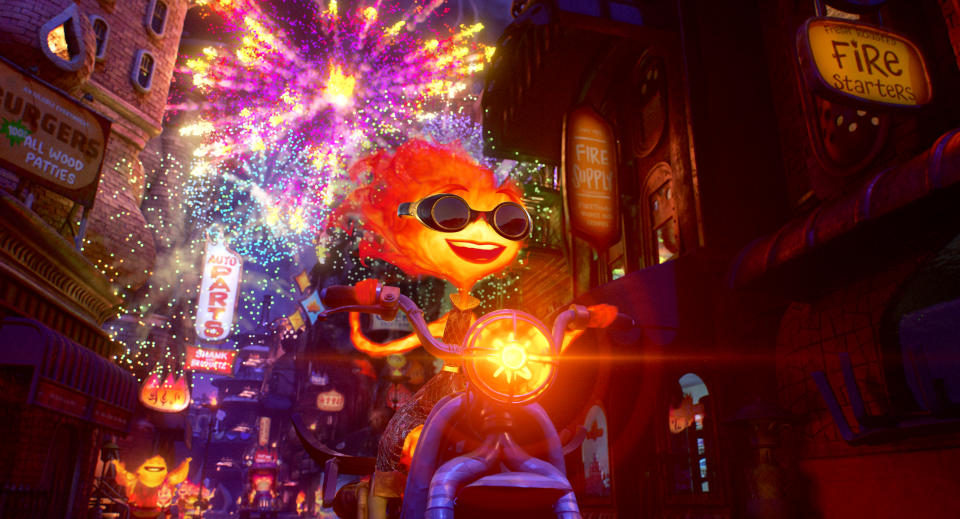Pixar’s ‘Elemental’ Is So Complex, It Required New Animation Technology

While Pixar has delivered innovative characters in recent years, including the ethereal Joe from “Soul” and the illuminating Joy from “Inside Out,” they aren’t nearly as complex as the fiery Ember and watery Wade in the upcoming “Elemental.” These two stars of Peter Sohn’s rom-com and immigrant story (which closes the Cannes Film Festival on May 27 prior to its June 16 theatrical opening) represent the studio’s most fully simulated characters, which required creating new tools for rigging and performance along with establishing a new VFX-driven workflow.
Set in Element City, where there’s tension between fire, water, air, and earth, the antagonistic first encounter between the intense Ember (Leah Lewis) and the go-with-the-flow Wade (Mamoudou Athie) eventually leads to romantic sparks. But because the character design and world-building are inextricably linked, “Elemental” cleverly strips everything down to its core essentials.
More from IndieWire
Production designer Don Shank said it was “a delicate balance between physics, logic, and cartoony appeal.” Unlike most productions, though, “Elemental” was reverse-engineered because the physical nature of the characters defined their environments. Thus, Element City is a series integrated neighborhoods comprised of the organic materials that would complement (and survive) each element. And because fire is the most dangerous element, and Ember had the most screen time as the protagonist, she was developed first and became the catalyst for everything else.
The first challenge was to figure out what Ember looked like. The art department looked at photo and video reference for a fire. They initially experiments with an animated face on realistic fire but that didn’t work. After realizing the need to balance realism with stylization, they virtually assembled a group of animators, tech wizards, and production people to make a computer drawing of Ember. They iterated for months creating her look, which was self-illuminating, and emphasized energy over anatomy. They did the same for Wade as water in motion, which was more complicated because of reflection and refraction, and required special attention to streamline the look and not obscure his face.

“We’re used to complicated characters where the hair and the clothing are simulated, but very few times where characters are all simulated,” VFX supervisor Sanjay Bakshi told IndieWire. “The ‘Soul’ characters were volumes, but they didn’t change over time. Joy has this effervescent quality, but it’s kind of prepackaged, and it doesn’t change based on her emotions or the way she’s feeling. Ember and Wade are both fluid simulations, but the technologies are different. Ember’s flames are never particles, it’s a fluid sim from day one. She looks like [the flame] on a gas range and if you sculpted that into a character.
“One of the questions we asked Pete,” he continued, “was how big of a fire is her head? He said it should be like a campfire. That’s the kind of activity of the flames and intensity that he was thinking about, so that really helped us narrow it down.”
Then animation had to build a complex rig so the artists could make Ember expressive. Like Wade, she had nearly 10,000 individual controls. Once the physics-based animation was honed, the artists dialed it back with greater stylization to make her face more readable and the performance more human. The result was sophisticated sculpting and some classic squash-and-stretch, with 2D outlining to carve out her silhouette against bright backgrounds.
“There was so much more collaboration on this film,” said co-directing animator Gwen Enderoglu. “Usually animation and effects don’t interact. That was a totally new pipeline for us. Ember has this kind of fiery agitation to her and so much was leveled up once they brought in [voice actor Louis]. When we started our first sequence in animation back in December 2021, we didn’t know what the final look of the film was gonna be. We didn’t know what we were making until we got in there and made it, and so that was unusual for us.”

Yet what they achieved was a uniquely expressive animated character. Ember’s color changes to purple as she gets angrier, and when she moves her arms, the flames go out and reappear. Timing and spacing were difficult, though, when she’s roaming through a water park. “When that got rendered for the first time, it was really difficult to see the character,” said co-directing animator Allison Rutland. “The flames were too big and kind of blurry and so we had to develop the technology to minimize the flames through these fast actions and then get a control for the animators to tune that while they’re animating.
“There were so many layers, and each aspect was dialed individually,” Rutland continued. “Too much line work and it starts to feel too cartoony, and it was always just chasing that balance that Pete was looking for. He wanted it to be 70 percent realistic and 30 percent stylized or cartoony.”
One of the early scenes follows Ember on a bike making her daily deliveries through Fire Town (where she lives outside of Element City), succinctly providing a sense of her connection to the community. “And just how capable she is,” Enderoglu said. “Then, on the flip side, when she’s not in Fire Town, when she’s out at Element City, how uncomfortable she is in that space. That was not a world that was built for her to live comfortably, and how cautious and careful she has to be because they were the last [element] to move in. They were disruptive, they were the outsiders, the infrastructure was already there, so it makes for an interesting conflict.”
Best of IndieWire
Where to Watch This Week's New Movies, from 'The Starling Girl' to 'BlackBerry'
Every Palme d'Or Winner from the Cannes Film Festival, Ranked
Sign up for Indiewire's Newsletter. For the latest news, follow us on Facebook, Twitter, and Instagram.

 money
money 